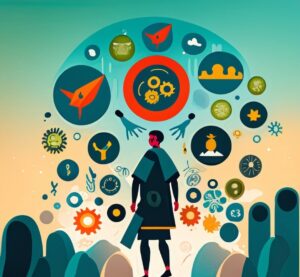Quantum computing is a new paradigm of computing that harnesses the strange properties of quantum physics to perform calculations exponentially faster than classical computers. Instead of using classical bits represented as 1s and 0s, quantum computers use quantum bits or “qubits” that can exist in a superposition of 1 and 0 at the same time. This allows quantum computers to process multiple calculations simultaneously enhancing Quantum Computing Overview.
The origins of quantum computing trace back to the 1980s when physicist Paul Benioff first proposed the idea of using quantum mechanics to build computers. In the 1990s, researchers like David Deutsch and Peter Shor further developed the theoretical foundations. Shor also invented the famous Shor’s algorithm to factor large numbers exponentially faster than classical algorithms for Quantum Computing Overview.
In recent years, practical quantum computers with just a few qubits have been built by companies like IBM, Google, Rigetti and D-Wave. While early quantum computers are limited, they represent the first steps toward fully functional quantum computers that can solve problems beyond the reach of even the most powerful supercomputers today.
Some key differences between quantum and classical computing:
– Qubits can represent a 1, a 0, or a quantum superposition of both at once. Classical bits are always in a definite state of 0 or 1.
– Quantum computing utilizes quantum properties like entanglement and superposition to perform parallel computations. Classical computing uses binary logic and performs computations sequentially.
– Quantum algorithms like Shor’s and Grover’s can achieve exponential speedups over the best known classical algorithms for certain problems.
– Quantum computing requires manipulating delicate quantum states and quantum error correction to deal with the fragility of qubits. Classical computing is built on robust digital logic gates.
While quantum computing is still in its early days, its unique approach offers the potential to revolutionize computing, science, and even cybersecurity in the decades to come.
- Modernizing Cybersecurity: Overcoming Legacy System Challenges : Read More

- Navigating Cybersecurity: From Hacktivism to Vulnerabilities : Continue Reading
Quantum Bits (Qubits)
Qubits are the basic units of information in quantum computing, similar to how bits are the basic units in classical computing. However, qubits exhibit some unique quantum mechanical properties that allow quantum computers to perform certain tasks much faster than classical computers.
The key difference between qubits and classical bits is that qubits can exist in a superposition of states. A classical bit can only exist in a 0 or 1 state, but a qubit can exist as a 0, 1, or a superposition of both states at the same time. This phenomenon is known as superposition and allows a qubit to essentially represent both 0 and 1 simultaneously.
Another related phenomenon is entanglement, where two qubits become correlated in a way that is impossible in classical physics. Even when the entangled qubits are physically separated, actions performed on one qubit affect the other. This allows quantum computers to explore multiple possibilities in parallel during computation.
Through superposition and entanglement, a quantum computer with just a few qubits can represent a vast number of states simultaneously. As the number of qubits increases, this exponential scale-up gives quantum computers the potential to be exponentially faster than classical computers for certain problems. Understanding qubits is key to understanding the power and potential of quantum computing.
Quantum Algorithms and Quantum Computing Overview
Quantum algorithms leverage the unique properties of quantum physics to solve problems exponentially faster than classical algorithms. Two of the most important quantum algorithms are Shor’s algorithm and Grover’s algorithm.
Shor’s algorithm can factor large numbers efficiently, which has enormous implications for breaking commonly used encryption schemes like RSA that rely on the difficulty of factoring large primes. Specifically, Shor’s algorithm can find the prime factors of an integer in polynomial time compared to the exponential time required by the best known classical factoring algorithms. This could allow quantum computers to crack encryption methods used in banking, ecommerce, and government communications.
Grover’s algorithm provides a quadratic speedup over classical algorithms for searching unsorted databases. Classically, searching an unstructured database of N items requires O(N) time in the worst case. Grover’s algorithm can search the same database in O(sqrt(N)) time, providing up to a 100x speedup for large databases. This has numerous applications like pattern matching, bioinformatics, optimization problems, and machine learning.
Overall, quantum algorithms like Shor’s and Grover’s demonstrate the immense power of quantum computing for solving real world problems orders of magnitude faster than classical approaches. As quantum hardware matures, these algorithms will enable breakthroughs across many industries and fields.

- Navigating Tomorrow’s Classroom: EdTech Innovations Ahead 2000’s : Learn More
Quantum Hardware
The current state of quantum processors is still in early development, with limited qubit counts and high error rates. However, major advances have been made in recent years by leading technology companies and research labs.
Google and IBM currently lead in the number of qubits they have been able to incorporate into their prototype quantum processors. In 2019, Google announced its 53-qubit Sycamore processor. IBM offers cloud access to its quantum processors, with its largest at 65 qubits as of 2022. While these qubit counts may seem small, they represent significant engineering feats.
Other major players in quantum hardware include startups like Rigetti Computing, IonQ, and D-Wave Systems. D-Wave focuses on quantum annealing technology while the others are working on gate-based quantum computers. Government research organizations like NASA and national labs are also pushing quantum computing hardware forward to Quantum Computing Overview.
The main challenges with quantum processors are scaling up qubit count, reducing noise and errors, and managing quantum decoherence. Qubits are extremely fragile and lose their quantum state quickly, especially as more are added to a system. Complex error correction mechanisms will be required to achieve fault tolerant quantum computing. Stable qubit operation must be maintained near absolute zero temperature.
While there is still a long way to go, rapid progress is being made toward more advanced quantum processors. 100-200 qubit systems are likely within the next few years. However, it will take major leaps in technology to reach the thousands or millions of qubits required for many practical applications. Computing hardware remains one of the biggest bottlenecks toward realizing the full potential of this powerful technology.

- The Evolution of Pop Culture: How Social Media Shapes Trends and Influences Society 1990’s : Explore More
Quantum Cryptography and Quantum Computing Overview
Quantum cryptography utilizes the principles of quantum mechanics to enable secure communication between two parties. It differs fundamentally from classical cryptography in that it allows the communication parties to detect eavesdropping. This is made possible by encoding information in quantum states such as the polarization of photons.
The core principle behind quantum cryptography is the Heisenberg Uncertainty Principle, which states that certain pairs of physical properties are related in a way that measuring one property prevents the observer from simultaneously knowing the other property. For example, when measuring the position of a particle, its momentum cannot be precisely determined.
This principle enables a technique called quantum key distribution (QKD), where keys for encrypting and decrypting messages are created using the quantum states of particles. The sender (Alice) transmits a sequence of photons representing bits through a quantum channel, and the receiver (Bob) measures their quantum state. If an eavesdropper (Eve) attempts to intercept and measure a photon, the very act of measurement will alter the quantum state in a detectable way due to the uncertainty principle. Thus, Eve’s presence can be detected, and the key is discarded.
The major advantage of QKD is that it allows two parties to produce a shared random secret key known only to them. This key can then be used to encrypt and decrypt messages. An important benefit is that it enables the detection of eavesdropping during key distribution. This means any third-party intervention can be identified before secure communication begins. Overall, QKD offers a more secure alternative to existing public key distribution schemes used in classical cryptography and Quantum Computing Overview.
Quantum Computing in the Cloud
- Accessing quantum computers remotely via cloud services allows more people to experiment with this emerging technology. Several tech companies now offer commercial quantum computing services through the cloud:
- Amazon Braket – Amazon Web Services offers access to quantum computers from D-Wave, IonQ, and Rigetti via its Braket service. Users can build algorithms and test them in simulated quantum environments or on actual quantum hardware.
- Microsoft Azure Quantum – Microsoft provides a cloud platform to develop and run quantum programs on systems from IonQ, Honeywell, and QCI. The Azure Quantum service aims to make quantum more accessible to developers.
- IBM Quantum – IBM was an early pioneer in quantum computing and now offers IBM Quantum services through its cloud. Researchers and developers can run algorithms on IBM’s own quantum systems as well as simulate quantum circuits.
- Google Cloud AI Quantum – Google provides quantum computing access through its Cloud AI services. Users can experiment with Google’s quantum processors and simulators via Jupyter notebooks.
The availability of quantum resources through major cloud platforms allows more people to gain hands-on experience with real quantum computers. As the technology continues advancing, cloud-based services will help drive wider quantum adoption.




